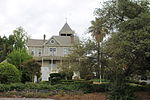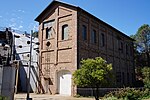Historic Folsom station
California railway station stubsFolsom, CaliforniaRailway stations in the United States opened in 2005Sacramento Regional Transit light rail stationsTram stubs

Historic Folsom station is a side platformed Sacramento RT Light Rail station in Folsom, California, United States. The station was opened on October 15, 2005, is operated by the Sacramento Regional Transit District and is the current eastern terminus of the Gold Line. The station is located near the intersection of Sutter Street and Reading Street, adjacent to the Western-themed city center.
Excerpt from the Wikipedia article Historic Folsom station (License: CC BY-SA 3.0, Authors, Images).Historic Folsom station
Folsom Boulevard, Folsom
Geographical coordinates (GPS) Address Nearby Places Show on map
Geographical coordinates (GPS)
| Latitude | Longitude |
|---|---|
| N 38.675833333333 ° | E -121.18055555556 ° |
Address
Folsom Boulevard
95671 Folsom
California, United States
Open on Google Maps






